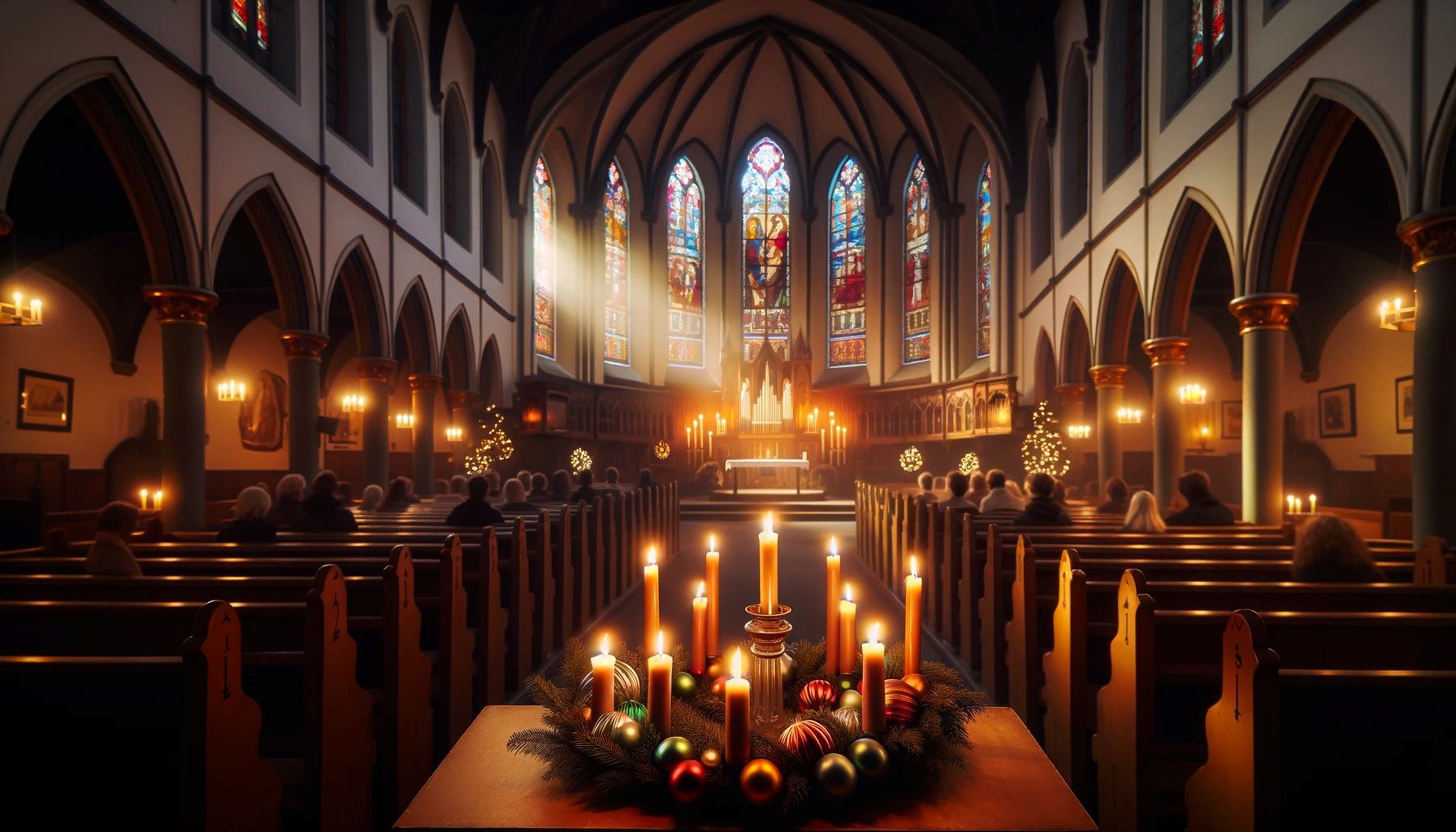Home>Special Themes>What Is The Advent Season?


Special Themes
What Is The Advent Season?
Published: February 14, 2024
Ericka Andersen, an editor at Christian.net, expertly merges digital strategy with content creation, focusing on faith and societal issues. Her communication skills enhance the platform's engaging narratives, fostering meaningful dialogue on belief's impact on society.
Discover the significance of the Advent season and its special themes. Explore the traditions and meaning behind this cherished time of anticipation and preparation.
(Many of the links in this article redirect to a specific reviewed product. Your purchase of these products through affiliate links helps to generate commission for Christian.net, at no extra cost. Learn more)
Table of Contents
Introduction
The Advent season, which marks the beginning of the liturgical year in many Christian traditions, is a time of anticipation, preparation, and hope. It encompasses the four Sundays leading up to Christmas and is a period of spiritual significance for millions of people around the world. The word "Advent" is derived from the Latin word "adventus," meaning "coming" or "arrival," and it symbolizes the anticipation of the birth of Jesus Christ.
During this sacred season, believers reflect on the profound themes of hope, peace, joy, and love, which are represented by the four candles of the Advent wreath. Each week, a new candle is lit, signifying the progression towards the celebration of the birth of Jesus on Christmas Day. The Advent season invites individuals to pause, reflect, and prepare their hearts for the arrival of the Christ child.
This period is not only a time of spiritual reflection but also a season of joyful anticipation, as families and communities come together to partake in various traditions and rituals. From lighting the Advent candles to opening the doors of the Advent calendar, each custom holds deep symbolic meaning and fosters a sense of unity and shared faith.
As we delve into the history, meaning, and traditions of the Advent season, we will uncover the rich tapestry of customs and practices that have been cherished for centuries. This exploration will provide insight into the profound significance of Advent and the enduring impact it has on the hearts and minds of believers worldwide. Join us on this enlightening journey through the Advent season, where we will unravel the timeless traditions and delve into the spiritual essence of this sacred time.
Read more: What Is Advent Season About
History of Advent
The history of Advent can be traced back to the early centuries of Christianity, with its origins rooted in the practices of the Western Church. While the exact date of the inception of Advent is not definitively documented, it is believed to have emerged in the 4th and 5th centuries as a period of preparation for the celebration of the Nativity of Jesus. The early Christians sought to create a time of spiritual contemplation and anticipation leading up to the joyous occasion of Christ's birth.
The initial observance of Advent varied among different Christian communities, with some regions emphasizing fasting and penance, while others focused on joyful expectation and spiritual readiness. Over time, the structure and duration of Advent evolved, eventually settling into the four-week period that is widely recognized today.
One of the pivotal moments in the development of Advent was the Council of Tours in 567 AD, where the Church officially established the period of Advent as a season of preparation for the Feast of the Nativity. This decree solidified the significance of Advent within the liturgical calendar and set the stage for the traditions and customs that would come to define this sacred time.
As the centuries unfolded, the observance of Advent became more standardized, with the focus shifting towards spiritual reflection, prayer, and the anticipation of Christ's coming. The themes of hope, peace, joy, and love began to take center stage, symbolized by the lighting of the Advent candles and the reading of relevant scriptures.
The rich history of Advent is also intertwined with the influence of various cultural and religious practices, as different regions and denominations infused their unique customs into the observance of this season. This diversity has contributed to the richness and depth of Advent traditions, making it a time of profound significance for Christians across the globe.
Today, the history of Advent serves as a testament to the enduring legacy of faith, hope, and anticipation that has been passed down through generations. It stands as a reminder of the timeless truths and spiritual principles that continue to resonate with believers, uniting them in a shared journey of preparation and expectation as they await the celebration of the birth of Jesus Christ.
Meaning of Advent
The meaning of Advent extends far beyond the countdown to Christmas; it encapsulates a profound spiritual journey marked by anticipation, hope, and reflection. At its core, Advent represents the period of preparation for the celebration of the birth of Jesus Christ. It serves as a poignant reminder of the centuries-old longing for the arrival of the Messiah and the fulfillment of God's promise to humanity.
The essence of Advent is intricately woven with the themes of hope, peace, joy, and love, each symbolized by the four candles of the Advent wreath. These themes resonate deeply with believers, offering a guiding light through the darkness and a source of comfort amidst the trials of life. As the weeks progress, the lighting of the candles serves as a tangible representation of the increasing anticipation and the gradual illumination of the path towards the arrival of Christ.
Moreover, Advent invites individuals to embark on a spiritual journey of introspection and preparation. It encourages believers to examine their hearts, cultivate a spirit of expectancy, and align their lives with the profound significance of Christ's birth. This period of reflection fosters a sense of mindfulness and spiritual readiness, allowing individuals to fully embrace the transformative power of the Christmas message.
Furthermore, the meaning of Advent transcends the confines of religious observance, resonating with people of diverse backgrounds and beliefs. It serves as a universal symbol of hope and renewal, offering a beacon of light in times of uncertainty and a reminder of the enduring promise of a brighter tomorrow.
In essence, the meaning of Advent encapsulates the timeless message of faith, renewal, and the anticipation of a new beginning. It calls upon individuals to embrace the spirit of hope, to seek peace amidst chaos, to rejoice in moments of joy, and to embody love in its purest form. As the world collectively prepares for the celebration of Christmas, the profound significance of Advent continues to inspire hearts and minds, illuminating the path towards the arrival of the Christ child with unwavering hope and profound meaning.
Advent Traditions
The Advent season is steeped in rich traditions that hold deep symbolic significance and foster a sense of unity and spiritual reflection. These time-honored customs have been cherished for centuries, serving as a poignant reminder of the anticipation and preparation for the celebration of the birth of Jesus Christ. From the lighting of the Advent candles to the opening of the doors on the Advent calendar, each tradition carries profound meaning and evokes a sense of reverence and joy.
Advent Wreath
One of the most iconic symbols of the Advent season is the Advent wreath, adorned with evergreen branches and four candles, typically three purple and one pink, arranged in a circle. Each candle represents a different week of Advent, with the first candle symbolizing hope, the second representing peace, the third signifying joy, and the fourth embodying love. As the weeks progress, a new candle is lit, illuminating the path towards the celebration of Christmas and serving as a visual representation of the increasing anticipation and spiritual enlightenment.
Advent Calendar
The Advent calendar, with its intricately numbered doors or compartments, has become a beloved tradition in many households. Each day leading up to Christmas, a door is opened to reveal a small treat, scripture verse, or act of kindness, serving as a daily reminder of the joyous anticipation and spiritual significance of the season. This cherished tradition not only brings families together but also instills a sense of wonder and excitement as each day unveils a new revelation or token of love.
Advent Candles
The lighting of the Advent candles holds profound symbolism, with each flame representing the growing anticipation and spiritual enlightenment as Christmas draws near. The act of lighting the candles each week fosters a sense of communal reflection and unity, as families and congregations gather to partake in this sacred ritual. The gentle glow of the candles serves as a beacon of hope and a reminder of the enduring light that Christ brings into the world.
Advent Music
Music plays a pivotal role in the observance of Advent, with hymns and carols carrying the timeless message of hope, peace, joy, and love. These melodic expressions of faith and anticipation resonate deeply with believers, evoking a sense of reverence and spiritual contemplation. From traditional hymns to contemporary compositions, Advent music serves as a powerful conduit for conveying the profound themes of the season and uniting hearts in joyful anticipation.
In essence, the Advent traditions serve as a tapestry of customs and rituals that weave together the timeless themes of hope, peace, joy, and love. These cherished practices not only enrich the observance of the Advent season but also foster a sense of unity, reflection, and spiritual preparation as believers eagerly anticipate the celebration of the birth of Jesus Christ.
Advent Wreath
The Advent wreath stands as a timeless symbol of the Advent season, embodying the profound themes of hope, peace, joy, and love. Adorned with evergreen branches and adorned with four candles, typically three purple and one pink, the wreath serves as a visual representation of the anticipation and spiritual enlightenment leading up to the celebration of Christmas.
Each candle on the Advent wreath holds deep symbolic significance, representing the four weeks of Advent. The first candle, often purple, symbolizes hope, signifying the eager anticipation of the Messiah's arrival and the promise of redemption. As the first candle is lit, it illuminates the path towards the joyous celebration of Christ's birth, infusing hearts with a sense of optimism and expectation.
The second candle, also purple, represents peace, serving as a poignant reminder of the tranquility and harmony that Christ brings into the world. As this candle is lit, it evokes a spirit of serenity and contemplation, inviting individuals to embrace the profound peace that transcends all understanding.
The third candle, typically pink, symbolizes joy, radiating a sense of exuberance and celebration as Christmas draws near. Its gentle glow embodies the infectious joy that permeates the hearts of believers, inspiring a spirit of jubilation and gratitude for the imminent arrival of the Christ child.
The fourth candle, again purple, embodies love, encapsulating the profound message of God's unconditional love for humanity. As this candle is lit, it serves as a poignant reminder of the transformative power of love and the enduring promise of salvation through the birth of Jesus Christ.
As the weeks progress, the lighting of each candle on the Advent wreath becomes a tangible representation of the increasing anticipation and spiritual enlightenment. The gentle glow of the candles fosters a sense of communal reflection and unity, as families and congregations gather to partake in this sacred ritual. The Advent wreath serves as a beacon of hope, illuminating the path towards the celebration of Christmas and evoking a profound sense of reverence and joy.
In essence, the Advent wreath stands as a cherished tradition that encapsulates the timeless themes of hope, peace, joy, and love, serving as a poignant reminder of the anticipation and preparation for the celebration of the birth of Jesus Christ.
Advent Calendar
The Advent calendar, with its intricately numbered doors or compartments, has become a beloved tradition in many households. Each day leading up to Christmas, a door is opened to reveal a small treat, scripture verse, or act of kindness, serving as a daily reminder of the joyous anticipation and spiritual significance of the season. This cherished tradition not only brings families together but also instills a sense of wonder and excitement as each day unveils a new revelation or token of love.
The origins of the Advent calendar can be traced back to 19th-century Germany, where families marked the days of Advent by drawing chalk lines on their doors or lighting candles. The first printed Advent calendar is believed to have appeared in the early 20th century, featuring religious images or biblical verses behind each door. Over time, the Advent calendar evolved to include small gifts, chocolates, or other tokens of joy, captivating the hearts of children and adults alike.
Today, the Advent calendar takes on various forms, ranging from traditional paper designs to modern renditions with interactive digital features. Regardless of its format, the Advent calendar serves as a daily reminder of the spiritual journey towards Christmas, fostering a sense of anticipation and reflection.
The act of opening each door on the Advent calendar becomes a cherished ritual, evoking a spirit of excitement and wonder as individuals uncover the hidden treasures within. Whether it's a piece of chocolate, a thoughtful message, or a small act of kindness to be performed, each revelation serves as a poignant reminder of the joyous anticipation and spiritual significance of the season.
Moreover, the Advent calendar serves as a tangible expression of the countdown to Christmas, infusing each day with a sense of purpose and expectation. It encourages individuals to pause, reflect, and embrace the profound themes of hope, peace, joy, and love as they journey towards the celebration of the birth of Jesus Christ.
In essence, the Advent calendar stands as a cherished tradition that encapsulates the joyous anticipation and spiritual significance of the Advent season. It serves as a daily reminder of the transformative power of the Christmas message, infusing hearts with wonder, joy, and a deep sense of spiritual preparation as believers eagerly await the arrival of the Christ child.
Advent Candles
The lighting of the Advent candles holds profound symbolic significance, serving as a poignant ritual that embodies the increasing anticipation and spiritual enlightenment leading up to the celebration of Christmas. The Advent wreath, adorned with evergreen branches and four candles, typically three purple and one pink, stands as a visual representation of the journey towards the arrival of the Christ child.
Each candle on the Advent wreath represents a different week of Advent, with the first candle symbolizing hope, the second representing peace, the third signifying joy, and the fourth embodying love. As the weeks progress, a new candle is lit, illuminating the path towards the celebration of Christmas and serving as a tangible representation of the growing anticipation and spiritual illumination.
The first candle, often purple, symbolizes hope, signifying the eager anticipation of the Messiah's arrival and the promise of redemption. As the first candle is lit, it infuses hearts with a sense of optimism and expectation, illuminating the path towards the joyous celebration of Christ's birth.
The second candle, also purple, represents peace, serving as a poignant reminder of the tranquility and harmony that Christ brings into the world. As this candle is lit, it evokes a spirit of serenity and contemplation, inviting individuals to embrace the profound peace that transcends all understanding.
The third candle, typically pink, symbolizes joy, radiating a sense of exuberance and celebration as Christmas draws near. Its gentle glow embodies the infectious joy that permeates the hearts of believers, inspiring a spirit of jubilation and gratitude for the imminent arrival of the Christ child.
The fourth candle, again purple, embodies love, encapsulating the profound message of God's unconditional love for humanity. As this candle is lit, it serves as a poignant reminder of the transformative power of love and the enduring promise of salvation through the birth of Jesus Christ.
The act of lighting the candles each week fosters a sense of communal reflection and unity, as families and congregations gather to partake in this sacred ritual. The gentle glow of the candles serves as a beacon of hope and a reminder of the enduring light that Christ brings into the world.
In essence, the Advent candles stand as a cherished tradition that encapsulates the timeless themes of hope, peace, joy, and love, serving as a poignant reminder of the anticipation and preparation for the celebration of the birth of Jesus Christ.
Advent Music
Advent music holds a profound and integral role in the observance of the Advent season, serving as a powerful conduit for conveying the timeless themes of hope, peace, joy, and love. From traditional hymns to contemporary compositions, the melodic expressions of faith and anticipation resonate deeply with believers, evoking a sense of reverence and spiritual contemplation.
The melodies of Advent music carry the rich tapestry of the Christmas message, weaving together the narratives of the anticipation and preparation for the birth of Jesus Christ. These timeless compositions not only uplift the spirits of congregations and communities but also serve as a source of inspiration and reflection during this sacred season.
One of the hallmark features of Advent music is its ability to evoke a sense of anticipation and longing, mirroring the centuries-old yearning for the arrival of the Messiah. Through poignant lyrics and stirring melodies, these musical expressions encapsulate the essence of Advent, inviting listeners to embark on a spiritual journey of introspection and preparation.
Traditional hymns such as "O Come, O Come, Emmanuel" and "Come, Thou Long Expected Jesus" resonate deeply with believers, capturing the spirit of hopeful expectation and the enduring promise of redemption. These timeless melodies serve as a poignant reminder of the profound significance of Christ's birth and the transformative power of the Christmas message.
In addition to traditional hymns, contemporary compositions have also become an integral part of the Advent music repertoire, offering fresh perspectives on the themes of hope, peace, joy, and love. These modern renditions infuse the observance of Advent with a sense of vibrancy and relevance, resonating with diverse audiences and fostering a deeper connection to the timeless message of the season.
Moreover, the communal aspect of Advent music further enriches the observance of the season, as congregations and choirs come together to lift their voices in harmonious praise. The collective singing of Advent hymns and carols fosters a sense of unity and shared faith, creating a sacred space for reflection and spiritual renewal.
As believers immerse themselves in the melodies of Advent music, they are transported on a poignant journey of anticipation and preparation, embracing the timeless themes that define this sacred season. The harmonious strains of these musical expressions serve as a testament to the enduring legacy of faith and hope, uniting hearts in joyful anticipation as they eagerly await the celebration of the birth of Jesus Christ.
Conclusion
The Advent season, with its rich history, profound meaning, and cherished traditions, stands as a testament to the enduring legacy of faith, hope, and anticipation. As we journey through the four weeks leading up to Christmas, we are reminded of the timeless themes of hope, peace, joy, and love that encapsulate the essence of this sacred season.
The history of Advent, rooted in the early centuries of Christianity, reflects the deep longing for the arrival of the Messiah and the establishment of a period of spiritual preparation and reflection. Over the centuries, the observance of Advent has evolved, weaving together diverse cultural and religious practices to create a tapestry of customs that resonate with believers across the globe.
The meaning of Advent transcends the countdown to Christmas, inviting individuals to embark on a spiritual journey of introspection and preparation. It serves as a poignant reminder of the enduring promise of a brighter tomorrow and the transformative power of the Christmas message. The themes of hope, peace, joy, and love infuse the Advent season with a sense of purpose and anticipation, guiding believers towards the celebration of the birth of Jesus Christ.
The cherished traditions of the Advent season, from the lighting of the Advent candles to the opening of the doors on the Advent calendar, foster a sense of unity, reflection, and spiritual preparation. These time-honored customs serve as a tangible expression of the anticipation and joy that permeate the hearts of individuals and communities as they eagerly await the arrival of the Christ child.
As the Advent wreath illuminates the path towards Christmas, each candle symbolizes a distinct theme, evoking a spirit of optimism, tranquility, exuberance, and love. The Advent calendar, with its daily revelations, infuses each day with wonder and anticipation, while the melodic expressions of Advent music resonate deeply with believers, uniting hearts in joyful anticipation.
In conclusion, the Advent season continues to inspire hearts and minds, illuminating the path towards the arrival of the Christ child with unwavering hope and profound meaning. It serves as a timeless reminder of the enduring promise of redemption and the transformative power of faith, inviting individuals to embrace the spirit of hope, to seek peace amidst chaos, to rejoice in moments of joy, and to embody love in its purest form. As we eagerly anticipate the celebration of Christmas, the profound significance of Advent continues to unite believers in a shared journey of preparation and expectation, fostering a sense of unity, reflection, and spiritual renewal.













